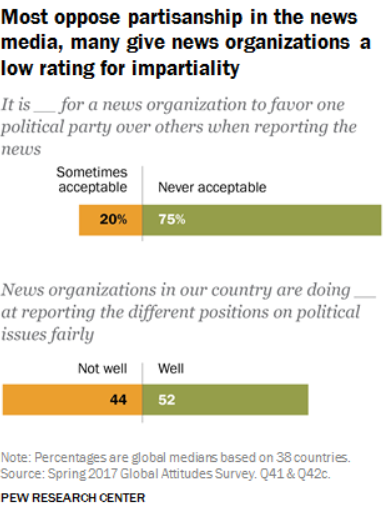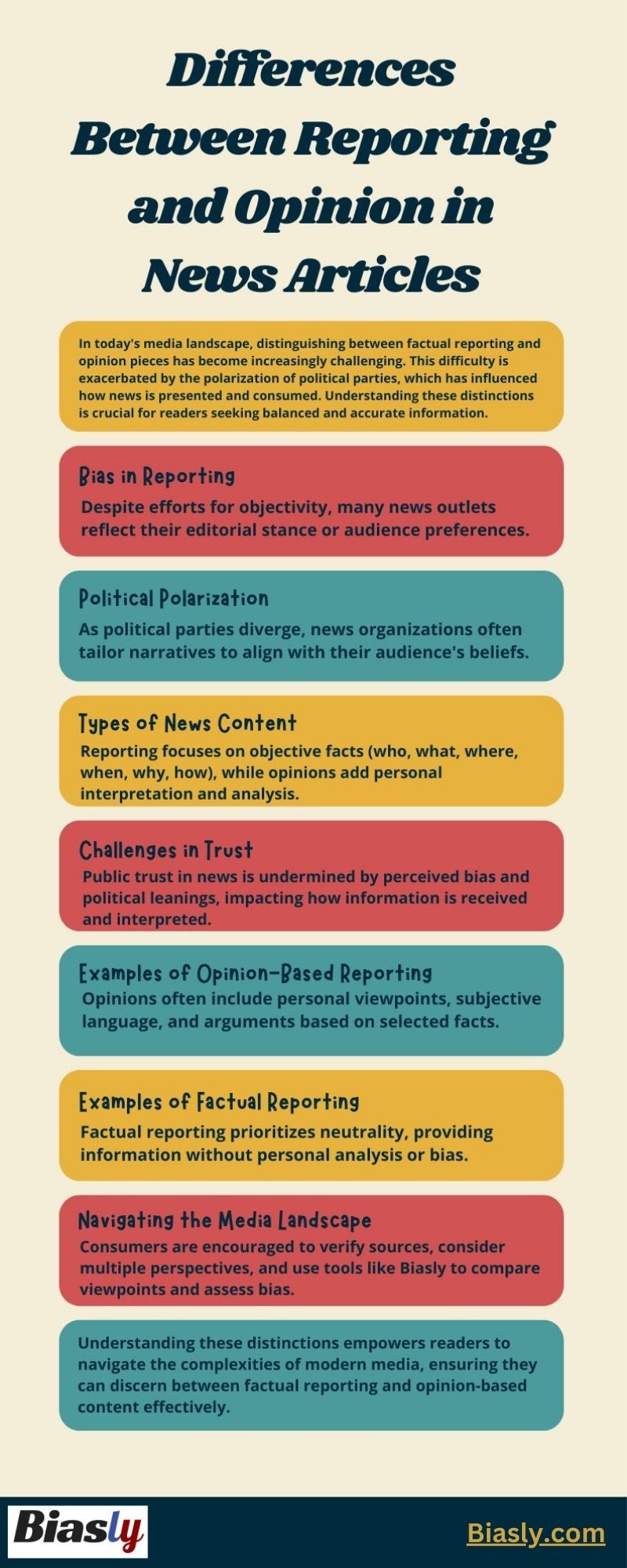
The issue of discerning reporting from opinions has become prevalent in the last 40 years. Sources such as Gallup have done polling on US citizens to try and determine how people feel about bias in the news. This poll demonstrates that most people believe that the news has gotten much worse about separating reporting from opinions. As the political parties have gotten more and more polarized, so too has our news. News organizations see an opportunity to engage consumers with narratives. These narratives have two components; reporting on stories, and authors’ opinions about them.
Definition of Reporting vs Opinion-based News Reporting
Reporting focuses on providing clear, unbiased facts. Usually, the who, what, where, why, and how of things. Opinions are the author’s spin on why the reporting is important. Most opinion pieces are based on a news story and attempt to make a general argument from it. Many non-opinion or “reporting” articles do the same but to a lesser degree. We encourage readers to take note of whether they are reading an opinion article or not, as opinion articles have a much higher degree of freedom when making arguments. Opinion articles can usually be found in the Opinion section of the website and clearly labeled as Opinion if on the home page. We can designate all other articles found on the news source’s site, at least for a reputable news source, as regular News Reporting or news with a reporting tone.
Opinion-based statements from the author typically contain these elements:
- The personal thoughts, opinions, and feelings of the author.
- “I” statements that usually convey an opinion about a certain subject.
- More adjectives and colorful language that display emotion.
- Political positioning and commentary on a certain topic.
- Directly agreeing or disagreeing with events, quotes, or facts.
Reporting or Non-opinion-based statements from the author typically include the following:
- Reporting about what happened.
- Focusing on objective language to explain actions and circumstances.
- Using facts, quotes, paraphrases, and other descriptions.
- Using a neutral tone.
- Lack of opinion.
The Inseparability of Opinions in Biased Reporting
Although we like to think we can separate the two, we often are unable to. Many of us claim to want unbiased and factual reporting (as seen in this Pew poll). Bias, fake news, and political leaning are the biggest reasons why many do not trust various news stations (See page 8 of the pdf). Despite this, we often do not consume unbiased media. It is difficult to understand the importance of many events without attaching a sort of narrative to them. This and an inability to find more unbiased media help contribute to the problematic media environment we see today.

Source: Pew Research
This poll conducted on internet users argues that the origin of news is one of the biggest determiners when it comes to determining news trustworthiness. This further exacerbates the problem, as well as the difficulty in determining what is an opinion and what is factual reporting.
So we have established the problem- that news has become more and more biased. We have also established that the general public views news as untrustworthy based on political leaning. These problems feed each other, making it difficult to explain the difference between reporting and opinions. With that said, if an author presents their opinion in a news story, that does not mean that the article is unreliable. Through readers having increased empathy for the author, they can better understand how the author came to their conclusion. Listening to multiple perspectives is helpful in trying to come to your own conclusions.
Many people choose to accept that the news they watch is flawed. They attempt to separate the factual news from the speaker or author’s analysis. This can be pretty challenging for a variety of reasons. The most pressing reason is that a news organization may only cover a story because it fits its political leaning. There are thousands of newsworthy events that happen every day. Oftentimes the stories that filter from local news to national news are extreme and click-bait. National news organizations choose from the local stories that filter up, oftentimes giving airtime to stories that fit a political agenda. If you were to take only the factual accounts from a news story, you may have a skewed understanding of reality.
Let’s generalize the Chinese Bank robber fallacy for instance. This isn’t a concrete academic theory or anything, but it is a useful thought experiment. If you were to see a story of a bank robbery in China every day, you would probably conclude that bank robberies are a big issue in China. In reality, a country of 1.4 billion people with 365 bank robberies may not actually be that sensational. In the same way, a news station that gives undue air-time to a specific issue may blow the scope of that issue out of proportion compared to other topics. It is important to consider this when separating factual reporting from opinion-based reporting.
Examples in Opinion-based Reporting
Here are some examples of individual opinion-based statements that can often be found in Opinion-based Reporting:
- “The marchers kept a fast pace, which was kind of interesting”
- “They were in Tallahassee protesting DeSantis’s crusade against everything “woke,””
- “DeSantis’s obsession has led him to restricting the teaching of Black history”
- “You might disagree — perhaps strongly — with Rowling’s views and actions here.”
- “She appears to support transgender ideologies which I disagree with”
The following opinion piece by the NY Post will help us illustrate the differences between opinion writing and factual reporting. The article focuses on two different reports. The first being several arrests regarding violent conduct and their historical criminal records. The second is a cashless bail reform law passed by the New York State Governor, Kathy Hochul. On their own, these reports are not biased or opinionated. The author’s opinions manifest in how they connect these two events and articulate an argument against cashless bail. The argument made is as follows:
“Before the no-bail law, the ex-con would surely have been jailed in one of those earlier cases. But now serial offenders routinely get revolving-door treatment until they draw blood — the law leaves judges no choice.”
The author inputs their own analysis, guided by their own opinions, to make the argument against cashless bail. They supply the evidence needed to make their conclusion logical and reasonable. Many people would find this argument sound and convincing. What is important to analyze, however, is that the author is picking specific news stories and specific incidents to make their argument. It is entirely possible that someone with access to the data regarding criminal offenses while on bail in New York may not see a big deal out of the article’s evidence.
It is also important to mention what this article does not discuss. Generally, no-cash bail is meant to allow people with non-violent offenses to continue working and supporting their families. For example, an opinion piece supporting no-cash bails may recount a story of someone who was convicted of a minor drug charge and was able to support their family, allowing them to show up to court when scheduled and pay any necessary fines. An article supporting no-cash bail would focus on arguments painting no-cash bail as positive and ignore offenders that commit crimes while awaiting a trial like what the opinion piece focuses on. It is important to try and keep various pieces of reporting in perspective and try to look at differing perspectives.
This article by MSNBC addresses both the benefits of no-cash bails and the alternative arguments that typical cash-bail advocates use. By doing this, they add more credibility to their article:
“Supporters say ending or limiting cash bail makes the pretrial system fairer, keeping poor people out of jail simply because they can’t afford to make bail. In New York City, for example, the average cost of bail in December 2021 was almost $40,000, according to an analysis provided by the city comptroller’s office, while the median income per capita is $41,625.”
“And although many areas are reporting higher crime rates, Scott Hechinger, a civil rights attorney and the founder of Zealous — a national criminal justice and advocacy organization — said it’s misleading to tie bail changes to crime surges because ‘reforms happened in very few places, rising crime happened everywhere.'”
These paraphrases and direct quotes are provided in such a way that it creates an imbalance that implies a preference for no-cash bails.
Let’s look at another opinion piece by Fox News.
“Unfortunately, recent Democrat administrations – and Joe Biden’s is no exception – have made race, gender, and controversial political teachings an integral part of military training and values, from the Pentagon to our service academies.”
The author makes his position very clear in the thesis of his article by displaying his disagreement with what he perceives to be the Biden administration’s priorities. We can expect the rest of the article to follow suit and defend his argument. Opinion articles also do not require strict reporting. Take the following for example:
“A recent Reagan National Defense Survey found that the number of Americans with a “great deal” of confidence in the military has plummeted from 70 percent in 2018 to 45 percent now. The largest decline in trust comes among Republicans, whose strong confidence fell from 87 percent to 53 percent – a disturbing 34 percent drop.”
The article uses a couple of pieces of evidence to explain this drop as noted below.
“Soon after Joe Biden became president, the Pentagon ordered an unprecedented military-wide ‘stand down’ of service members to root out right-wing domestic extremists, wasting 5.8 million man-hours. The Pentagon then hired Diversity, Equity, and Inclusion Officers at salaries as high as $200,000. For the past two years, the Department of Defense rigidly enforced vaccine requirements, cutting off tens of thousands of service members from benefits, even when many have legitimate objections and are young, healthy adults.”
“In recent years, the academies have also taught radical doctrines like Critical Race Theory under the label of ‘diversity and inclusion.’ The Air Force Academy established a special ‘Diversity and Inclusion reading room’ that it described as a “safe space” for America’s young warriors. It also created an organization of hand-picked cadets – identified by a purple braid on their dress uniform—to spread these controversial ideals in the ranks. At West Point, cadets can now minor in “Diversity and Inclusion Studies” alongside cadets studying serious subjects like Grand Strategy, Aeronautical Engineering, and Nuclear Science.”
It is important to note that causality here is interpreted by the author without including reputable linked sources, statistics, or much supportive analysis. Adding these items would provide additional support and improve their argument.
What many from the liberal side argue is that the efforts taken by the Biden Administration aim to bring in more recruits from demographics typically underrepresented in the modern military such as left-leaning individuals, as the article claims, or minority communities. The goal is to solve the recruitment deficit and trust issues that the article discusses. Because this is an opinion article, only one side needs to be articulated. For the sake of balance, let’s look into why these investigations are happening.
Multiple defense agencies came together to agree on pursuing investigations on extremism within the military. According to this CSIS blog post, these investigations “came amid growing concern over extremist network efforts to tailor recruitment toward military personnel and an increase in criminal cases involving extremism in the ranks.”
The author also argues that these investigations are important because “military personnel can add larger-than-average value to extremist networks due to their specialized knowledge and abilities—including communications, logistics, and tactical skills.” The author also discusses that terror attacks perpetrated by active or former military personnel had increased from 1.5% of all terror-related cases to 6.1% of terror-related cases from 2019 to 2020. The post also mentions that this isn’t the first time the DOD has investigated extremism, with the last time being in 1995 due to a bombing in Oklahoma and the Fort Bragg murders.
Whether each side of the aisle agrees with the other side or not, it is helpful for readers to consider both set of claims and evidence to make an informed judgment. As we can see, there are multiple perspectives involved in most news stories. It is important to challenge the beliefs of each and get third-party verification of what you are hearing is the full story. This is why we recommend using Biasly to compare different news stories side-by-side using our bias ratings to figure out what both sides think of a political issue.
Examples of News Reporting Without Opinion
Here are some examples of reporting statements without opinion that can often be found in standard news reporting:
- “On Twitter she declared, “You’re burning the wrong witch.”“
- “She included a transgender character in another novel.“
- “Trump, who has launched a third White House bid“
- “Biden is the oldest president in history”
- “South Carolinian Sen. Tim Scott is also weighing a White House bid.“
Let’s review an article to try and discern what to look for when we want to see factual or standard news reporting without opinion. This article from Fox News regarding North Korea’s recent ICBM test provides very little to no author analysis or bias. The article is factual reporting due to the use of direct quotations, direct descriptions of events, and frequent references to reports of the event. There are little to no instances of the author comparing parties’ responses to the event, arguing their preferred response, or condemnation of a response to the event.
However, to some extent, the author’s choice to include condemnations of North Korea indicate some bias, favoring America and peace, which makes sense considering this is an American newspaper. For example,
“North Korea’s launch of a ballistic missile is an act of grave provocation that threatens the peace and security of the Korean peninsula and international community,” South Korea’s Joint Chiefs of Staff said in a statement Sunday.
In a perfectly balanced article, the author would feature a response from North Korean officials. That kind of reporting probably isn’t possible in the current geopolitical arrangement of the world, however, this article is about as close as you can get to 100% factual reporting regardless, and Biasly rates it as center-leaning.
Academic Papers and Studies in Standard News Reporting
Another indication of factual non-biased reporting would be academic papers or studies. Academic papers go through peer review to ensure quality and accuracy. For sake of simplicity, let’s look at one of the prior papers mentioned earlier:
This Gallup & Knight study shows that the trustworthiness of news depends on its source. All analysis they perform is based strictly on patterns that credited researchers notice and attempt to form theories around. This doesn’t mean the theories can’t be biased because of natural human element, but it could mean that it is more factual.
To see how news organizations can use research to create a biased political narrative, let’s look at this article by CNN. A quick readthrough gives several themes relating to the author’s key arguments. In summary, India is at risk of missing critical renewable energy targets and is considering expanding coal use. India has made considerable leaps in renewable energy as a percent of its total energy output but lacks the critical funds needed. These arguments made by the author are guided by research from various sources such as EDGAR, Climate Action Tracker, and the Yale Program on Climate Change Communication. Although the research papers all agree on the problem, the author’s argument is that:
“The developed world was supposed to be providing $100 billion a year to developing nations to help them slash their emissions and adapt to the climate crisis. That goal has never been met… If India doesn’t receive the financial support it needs, maintaining its pace on developing renewable energy will be difficult. Increasing it will be even harder.”
If the author had only reported on the findings from the aforementioned research reports, then it would only be reporting. The author indicates that developed countries should be helping to solve this problem of climate change in India is an opinion that the author is arguing for.
Objective reporting is devoid of argument, perspective, or author input. Researchers may make recommendations based on their professional knowledge or input, but those should be interpreted carefully when coming from a news reporter. The author’s opinion is typically a call to action, an argument, comparing different political stances in a way that shows a preference, omitting the other side of an argument, or creating an argument by linking different reports together to form a narrative.
It can be tricky to sort all of this out, but due diligence can pay dividends in helping you navigate the current media environment. Biasly helps with this by providing side-by-side news stories to help you see both sides of a perspective. This will allow you to verify events that happen, as well as to see how different political sides view a given issue.























